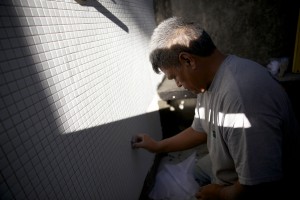‘fluxHome’ to compete in Solar Decathlon
USC’s fluxHome will compete in the Solar Decathlon, a biennial competition sponsored by the U.S. Department of Energy, this October at the Orange County Great Park.

Home of the Future · A contractor spreads grout over tiles in the fluxHome. The house showcases eco-friendly building techniques. – Ralf Cheung | Daily Trojan
FluxHome project manager Justin Kang, a USC alumnus of the School of Architecture, explains that, the contest means more than just winning to the DOE.
“For the DOE, this competition focuses on educating the public on sustainable living,” Kang said.
USC, however, uses this competition to allow students to go further than simply designing and developing projects, such as the fluxHome, by allowing for actual construction. This project provides a unique experience as students are required to build a fully electric home that is valued under $250,000, excluding land acquisition costs.
USC’s fluxHome is uncommon because it is the only entry designed for a family of four, as well as being the largest house in the competition.
The innovative design of the house uses natural weather as much as possible before using electricity to control the internal temperature and environment. The large operable skylights allow for natural ventilation, and the many windows and openings to the outside world create enough natural light to remove the need for electric lighting during the daylight hours.
“We wanted to create an affordable home and push the gap between indoor and outdoor,” said Christopher Flynn, recent USC School of Architecture graduate and construction manager for electrical, photo voltaic, lighting and Leadership in Energy and Environmental Design (LEED) responsibilities.
Along with an innovative design, the fluxHome also sports numerous green features such as sensors on each light that show how much energy it is using in dollars, so that people can track how much energy they use daily.
An especially exciting feature is the Crestion unit, which can sense when to turn on or turn off the air conditioning or heater. It can also hook up to an iPad.
“It augments everything in the house using keypads. It is helping the user get the best out of the house by measuring electricity and using everything responsibly,” Flynn said.
The competition allows students to focus on the numerous real-world issues that affect middle class housing through its 10 separate contests. Three of these contests relate to energy and efficiency as expected, while the rest extend to areas such as design, affordability, market appeal, communications and home entertainment.
“The cinematic arts students helped design the home entertainment system with the best and newest technology,” Kang said.
The project has also received plenty of attention from the community with organizations such as the LADWP and Southern California Edison giving strong support in addition to the money donations, labor, resources and materials from the design and construction community.
USC’s Neighborhood Academic Initiative program brought kids to the fluxHome where they were given a tour of the house and learned about what it means to be an architect. After the competition, Kim explained how the fluxHome is expected to tour several places both within the U.S. and abroad, after which it will be donated to a family in the area surrounding USC.
“It shows you that there are affordable ways to help the environment while still living comfortably and luxuriously,” Maite Christi Francois, a sophomore majoring in neuroscience said.
All Solar Decathlon entries will be open to the public during the competition, from Oct. 3-6 and 10-13 at Orange County Great Park in Irvine, Calif.

I don’t even understand how I ended up right here, but I believed this put up was great. I don’t
realize who you are however certainly you are going to a well-known blogger if you aren’t already. Cheers!